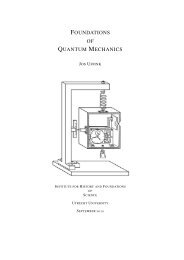Subjective probability and statistical physics
Subjective probability and statistical physics
Subjective probability and statistical physics
You also want an ePaper? Increase the reach of your titles
YUMPU automatically turns print PDFs into web optimized ePapers that Google loves.
distribution p α , i.e. to some point on the curve mentioned above. The question is<br />
thus how this shift would compare to Bayesian conditionalisation on the event E α .<br />
Now it is a general result, from the theorem of total <strong>probability</strong>, that the prior<br />
<strong>probability</strong> is always expressible as some convex mixture of my possible posterior<br />
probabilities. Thus:<br />
∫<br />
p prior<br />
i<br />
= P (A i ) = P (A i |E α )ρ(α)dα. (16)<br />
where ρ is some <strong>probability</strong> density for the events E α .<br />
But the shift from p prior to p α , according to the above MEP procedure, the initial<br />
belief p prior is generally not representable as a proper mixture of the future beliefs<br />
p α . Thus, these shifts are generally different from the shift in <strong>probability</strong> from prior<br />
to posterior from conditionalisation on the same empirical data.<br />
There are two ways to respond to this problem. First one might wish to make a<br />
sharp distinction between assigning <strong>probability</strong> <strong>and</strong> changing or updating a <strong>probability</strong><br />
assignment we already have (or between belief formation <strong>and</strong> belief kinematics).<br />
One may argue that the Maximum entropy Principle is designed for the first kind of<br />
problems while Bayesian conditionalisation is designed for the second. Thus, there<br />
would be a sharp division of labour between these two procedures without possibility<br />
of conflict.<br />
Unfortunately, this response seems to restrict the applicability of the MEP as a<br />
method of <strong>statistical</strong> inference drastically. Typically, it may be the case that information<br />
arrives step by step, at different times <strong>and</strong> one would like to adapt a <strong>probability</strong><br />
assignment several times. But according to the above division of labour, the MEP<br />
would not allow successive application. (As in the example above, where the MEP<br />
was applied first to determine the prior <strong>and</strong> then again to respond to the data E α . )<br />
The other response is to distinguish more sharply between events <strong>and</strong> constraints.<br />
As Jaynes argued in repsonse to the problem:<br />
“If a statement d refering to a <strong>probability</strong> distribution in a space S is<br />
testable (for example if it specifies the mean value 〈f〉 for some function<br />
f defined on S, then it can be used a a constraint in the PME; but it<br />
cannot be used as a conditioning statement in Bayes’ theorem because it<br />
is not a statement about any event in S or any other space.<br />
Conversely, a statement D about an event in the space S N (for example an<br />
observed frequency) can be used as a conditioning statement in applying<br />
Bayes’ theorem, [. . . ] but it cannot be used as a constraint in applying<br />
PME in space S because it is not a statement about [. . . ] any <strong>probability</strong><br />
distribution over S, i.e., it is not testable information in S. (Jaynes 1983,<br />
p. 250)”<br />
Now, while I agree with Jaynes that a sharp distinction between events <strong>and</strong> constraints<br />
is advisable, it is hard to reconcile this distinction with Jaynes’ own proposal in the<br />
example above to ”interpret” a statement about the occurrence of some event as a<br />
statement about a constraint.<br />
18
















